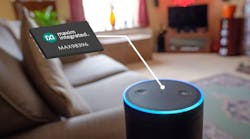Smart Class-D/G Amplifier Features Inaudible Noise Floor, Low Quiescent Power
The MAX98396 Class-D/G speaker amplifier developed by Maxim Integrated Products brings higher fidelity, longer battery life, and support for advanced features, such as gesture-based interfaces, to always-on remote and portable speakers. The 20-V digital input audio power amplifier consumes only 12.7 mW of quiescent power (at 12-V power VDD, or PVDD), which the company says represents a nearly 80% reduction over comparable amplifiers on the market. This meets or exceeds the industry’s power compliance regulations for the always-on feature in portable Bluetooth and smart speakers. The MAX98396’s low 15.5-µV rms noise floor is 50% lower than the closest competitor, allowing for speaker placement in near-silent locations.
In addition, the MAX98396 is “ultrasound ready,” built to support a digital data channel used as a control interface for smart speakers to implement advanced features like touchless gesture-based sensing, presence detection, and proximity sensing. This ultrasonic channel, operating at roughly 45 kHz, is made possible by the amplifier's upgraded sampling frequency of up to 192 kHz, and a 50-kHz ultrasound signal bypass path that prevents ultrasound signal attenuation by the audio-processing signal path.
The MAX98396 is available at Maxim’s website for $1.12 (1000-up, FOB USA), as well as from authorized distributors. The MAX98396EVSYS evaluation system is priced at $184. You can learn more about the MAX98396 from the video below or at the product’s home page: http://bit.ly/MAX98396Product.


